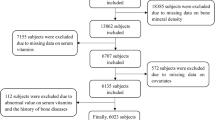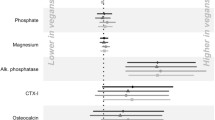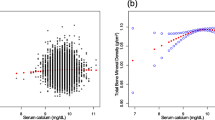Summary
Background
Cobalamin deficiency is prevalent in vegetarians and has been associated with increased risk of osteoporosis.
Aim of the study
To examine the association between cobalamin status and bone mineral density in adolescents formerly fed a macrobiotic diet and in their counterparts.
Methods
In this cross–sectional study bone mineral density (BMD) and bone mineral content (BMC) were determined by DEXA in 73 adolescents (9–15 y) who were fed a macrobiotic diet up to the age of 6 years followed by a lacto–(–ovo–) vegetarian or omnivorous diet. Data from 94 adolescents having consumed an omnivorous diet throughout their lives were used as controls. Serum concentrations of cobalamin, methylmalonic acid (MMA) and homocysteine were measured and calcium intake was assessed by questionnaire. Analysis of covariance (MANCOVA) was performed to calculate adjusted means for vitamin B12 and MMA for low and normal BMC and BMD groups.
Results
Serum cobalamin concentrations were significantly lower (geometric mean (GM) 246 pmol/L vs. 469 pmol/L) and MMA concentrations were significantly higher (GM 0.27 µmol/L vs. 0.16 µmol/L) in the formerly macrobiotic–fed adolescents compared to their counterparts. In the total study population, after adjusting for height, weight, bone area, percent lean body mass, age, puberty and calcium intake, serum MMA was significantly higher in subjects with a low BMD (p = 0.0003) than in subjects with a normal BMD. Vitamin B12 was significantly lower in the group with low BMD (p = 0.0035) or BMC (p = 0.0038) than in the group with normal BMD or BMC. When analyses were restricted to the group of formerly macrobiotic–fed adolescents, MMA concentration remained higher in the low BMD group compared to the normal BMD group.
Conclusion
In adolescents, signs of an impaired cobalamin status, as judged by elevated concentrations of methylmalonic acid, were associated with low BMD. This was especially true in adolescents fed a macrobiotic diet during the first years of life, where cobalamin deficiency was more prominent.
Similar content being viewed by others
References
Carmel R, Lau KH, Baylink DJ, Saxena S, Singer FR (1988) Cobalamin and osteoblast- specific proteins. N Engl J Med 319:70–75
Eastell R, Vieira NE, Yergey AL, Wahner HW, Silverstein MN, Kumar R, Riggs BL (1992) Pernicious anaemia as a risk factor for osteoporosis. Clin Sci Colch 82:681–685
Goerss JB, Kim CH, Atkinson EJ, Eastell R, O’Fallon WM, Melton LJ (1992) Risk of fractures in patients with pernicious anemia. J Bone Miner Res 7:573–579
Melton ME,Kochman ML (1994) Reversal of severe osteoporosis with vitamin B12 and etidronate therapy in a patient with pernicious anemia. Metabolism 43:468–469
Miller DR, Specker BL, Ho ML, Norman EJ (1991) Vitamin B-12 status in a macrobiotic community. Am J Clin Nutr 53:524–529
Krajcovicova-Kudlackova M, Blazicek P, Kopcova J, Bederova A, Babinska K (2000) Homocysteine levels in vegetarians versus omnivores. Ann Nutr Metab 44:135–138
Barr SI, Prior JC, Janelle KC, Lentle BC (1998) Spinal bone mineral density in premenopausal vegetarian and nonvegetarian women: cross-sectional and prospective comparisons. J Am Diet Assoc 98:760–765
Dagnelie PC, Van Staveren WA, Verschuren SA, Hautvast JG (1989) Nutritional status of infants aged 4 to 18 months on macrobiotic diets and matched omnivorous control infants: a population-based mixed-longitudinal study. I. Weaning pattern, energy and nutrient intake. Eur J Clin Nutr 43:311–323
Dagnelie PC, Van Staveren WA, Vergote FJ, Dingjan PG, van den Berg H, Hautvast JG (1989) Increased risk of vitamin B-12 and iron deficiency in infants on macrobiotic diets. Am J Clin Nutr 50:818–824
Dagnelie PC, Vergote FJ, Van Staveren WA, van den Berg H, Dingjan PG, Hautvast JG (1990) High prevalence of rickets in infants on macrobiotic diets. Am J Clin Nutr 51:202–208
Parsons TJ, Van Dusseldorp M, Van der Vliet M, Van de Werken K, Schaafsma G, Van Staveren WA (1997) Reduced bone mass in Dutch Adolescents fed a macrobiotic diet in early life. J Bone Min Res 12:1486–1494
van Dusseldorp M, Schneede J, Refsum H, Ueland PM, Thomas CM, de Boer E, Van Staveren WA (1999) Risk of persistent cobalamin deficiency in adolescents fed a macrobiotic diet in early life. Am J Clin Nutr 69:664–671
Lindenbaum J, Stabler SP, Allen RH (1988) New assays for cobalamin deficiency getting better specificity. Lab Manag 26:41–44
Dhonukshe-Rutten RAM, Lips M, De Jong N, Chin A Paw MMJ, Hiddink GJ, Van Dusseldorp M, de-Groot LCPG, Van Staveren WA (2003) Vitamin B-12 status is associated with bone mineral content and bone mineral density in frail elderly women but not in men. J Nutr 133:801–807
Tanner JM (1962) The development of the reproductive system. Growth at Adolescence. Blackwell Scientific Publications, Oxford, UK, pp 28–39
Schneede J, Ueland PM (1995) Application of capillary electrophoresis with laser-induced fluorescence detection for routine determination of methylmalonic acid in human serum. Anal Chem 67:812–819
Fiskerstrand T, Refsum H, Kvalheim G, Ueland PM (1993) Homocysteine and other thiols in plasma and urine: automated determination and sample stability. Clin Chem 39:263–271
Hulshof KFAM, Heiden-Winkeldermat HJ, Kistemaker C, Van Beresteijn ECH (1989) De calciuminneming uit zuivelprodukten: meting via een schriftelijke vragenlijst. Voeding 11:302–306
Stichting Nederlands Voedingsstoffenbestand (NEVO) (1993) NEVO tabel 1993 (Dutch Food and Nutrition table) (in Dutch). Den Haag
Prentice A, Parsons TJ, Cole TJ (1994) Uncritical use of bone mineral density in absorptiometry may lead to size-related artifacts in the identification of bone mineral determinants. Am J Clin Nutr 60:837–842
Klee GG (2000) Cobalamin and folate evaluation: measurement of methylmalonic acid and homocysteine vs vitamin B(12) and folate. Clin Chem 46:1277–1283
de Bree A, Verschuren WM, Kromhout D, Kluijtmans LA, Blom HJ (2002) Homocysteine determinants and the evidence to what extent homocysteine determines the risk of coronary heart disease. Pharmacol Rev 54:599–618
Hung CJ, Huang PC, Lu SC, Li YH, Huang HB, Lin BF, Chang SJ, Chou HF (2002) Plasma homocysteine levels in Taiwanese vegetarians are higher than those of omnivores. J Nutr 132:152–158
Lips P (2001) Vitamin D deficiency and secondary hyperparathyroidism in the elderly: consequences for bone loss and fractures and therapeutic implications. Endocr Rev 22:477–501
Zittermann A (2003) Vitamin D in preventive medicine: are we ignoring the evidence? Br J Nutr 89:552–572
Dagnelie PC, Van Staveren WA (1994) Macrobiotic nutrition and child health: results of a population-based, mixedlongitudinal cohort study in The Netherlands. Am J Clin Nutr 59:1187S–1196S
Van Dommelen CKV, Klaassen CHL (1964) Cyanocobalamin-dependent depression of the serum alkaline phosphatase level in patients with pernicious anemia. N Engl J Med 271:541–544
van Meurs JB, Dhonukshe-Rutten RA, Pluijm SM, Van Der Klift M, de Jonge R, Lindemans J, de Groot LC, Hofman A, Witteman JC, van Leeuwen JP, Breteler MM, Lips P, Pols HA, Uitterlinden AG (2004) Homocysteine levels and the risk of osteoporotic fracture. N Engl J Med 350:2033–2041
McLean RR, Jacques PF, Selhub J, Tucker KL, Samelson EJ, Broe KE, Hannan MT, Cupples LA, Kiel DP (2004) Homocysteine as a predictive factor for hip fracture in older persons. N Engl J Med 350:2042–2049
Author information
Authors and Affiliations
Corresponding author
Rights and permissions
About this article
Cite this article
Dhonukshe-Rutten, R.A.M., van Dusseldorp, M., Schneede, J. et al. Low bone mineral density and bone mineral content are associated with low cobalamin status in adolescents. Eur J Nutr 44, 341–347 (2005). https://doi.org/10.1007/s00394-004-0531-x
Received:
Accepted:
Published:
Issue Date:
DOI: https://doi.org/10.1007/s00394-004-0531-x




